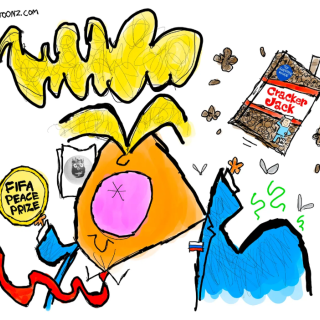Advertisement
It is entirely within the realm of possibility that hundreds of thousands of people have seen the amazing work of Ernest Withers, but didn’t know it. He was one of the most talented and prolific photographers of the modern-day freedom movement. A number of his images–including those of Martin Luther King, Jr., riding on an integrated bus in Montgomery, and the photo of Mose Wright, the extremely brave uncle of Emmett Till defiantly pointing his finger at the white man who kidnaped and killed the teenager–are beyond iconic. But Withers had a secret identity. A native black southerner, he was simultaneously an informant for the Federal Bureau of Investigation (FBI) in that same movement.
Born in Memphis, Tennessee, Withers first picked up a camera when he was in the eighth grade. A small square plastic Brownie 127 model with rounded sloping sides, it was manufactured in Great Britain for American distribution beginning in 1952. It was a popular first model for amateurs, and remained so through the end of the 1960s. Withers’ sister gave it to her boyfriend as a gift. Fortunately for Withers, the boyfriend didn’t want it. Withers asked the young man for the camera. His first professional shots were of Marva Louis, who was married to the legendary boxer, Joe Louis. She was a gorgeous model and singer, and appeared at his school. Standing in the back of the auditorium during her show, Withers could barely see her, and so slowly made his way down front. He finally found his shot, took it, and was smitten.
After high school, he married his girlfriend and joined the Army. That proved to be a fortuitous choice; it was there that he received formal training in how photography labs worked and learned how to develop film. Withers continued to take photos of everything, everybody, everywhere. Enamored with photography, he and a friend traded their weekly beer allowance for film and lab time. When he returned home, he took the money from his GI Bill and opened his own studio.
The tentacles of racism in Memphis are extraordinarily deep. From 1866 through 1955 the city passed almost two dozen Jim Crow laws regulating, among other subjects, education, public accommodates, race classification, and that proverbial white bugaboo, miscegenation. Presently, Memphis is like many other southern cities, proudly sharing its racial legacy through museums, walking tours, plaques, and the like. It has even found a way to present its most terrible claim to fame: the city in which Martin Luther King, Jr., met his death.
During the 1960s, the city was at the center of the Civil Rights Movement, as its large African-American population had been deeply affected by state segregation practices and disfranchisement in the early 20th century. In 1968, the Memphis sanitation strike for living wages and better working conditions began; the workers were overwhelmingly African American men. They marched to gain public awareness and support for their plight, the danger of their work, and the struggles to support families on their miserly pay. Their efforts had been met with stubborn resistance by the city government. It was this situation that attracted the attention of Dr. King, Jr.
In Bluff City Lauterbach reminds of the way things were in the south for blacks. Relegated to the most menial of jobs and hard scrabble lives, they lacked political power and support. Yet in Withers’ photographs, black people come across as resilient, strong, proud, and powerful. He captured the many mundane actions that made up daily black life; he gamely recorded their sorrow and suffering at the hands of white supremacy, and their participation in their own liberation. His photos are joyful, revealing, and spiritual.
Lauterbach certainly has the chops to tell this story. He is the author of -Beale Street Dynasty: Sex, Song, and the Struggle for the Soul of Memphis and The Chitlin’ Circuit: And the Road to Rock ‘n’ Roll, paeans to the history of the city’s vibrant music scene, which has been heavily influenced by African Americans. He proudly wears his love for Memphis on his sleeve.
In 2010 Marc Perrusquia, a reporter with the Memphis Commercial Appeal, had heard of the double life of Ernest Withers, and began writing stories. The paper eventually sued the FBI for access to the records under the Freedom of Information Act (FOIA). We see that Withers was investigated by the FBI in 1946. After leaving the military, he belonged to an organization called the United Negro Allied Veterans of America. The Bureau thought the group was a cover for communism in America.
Withers’ role as an official informant appears to have begun in 1968, where he was cited as ME 339-R (Ghetto). The information he provided was primarily general in nature, although he sometimes attended meetings where he took photos and passed them off to the FBI. He did, however, feed the Bureau detailed information about a so called black militant group named the Invaders. The group was sometimes involved in violence, and allegedly had links to prostitution and making firebombs. By 1970 his role as an informant ended.
The best part of Bluff City is Lauterbach’s powerful and detailed treatment of the Memphis sanitation strike. In addition to the photos, Withers was responsible for buying the wooden sticks that were stapled to the famous signs that read “I am a man.” The march quickly got out of control, and those same sticks were used as weapons during the melee.
When in 2013 Withers’ activities became public, there were basically three responses. The news was met with shock by his family. Some who had participated in the movement were very angry; they saw it as a tremendous betrayal. Andrew Young, a lieutenant of Dr. King, brushed off the photographer’s role as an FBI informant. He said he work of the movement was open and above board, and it had nothing to hide. Still others overlook Withers’ betrayal and focus on his work and its importance to the freedom movement
Withers justified his spying by saying that he never sat in on any important meetings, and that the information he fed to the FBI was generally of little value. He seems to have implied that like others on the periphery of the movement who were in a situation similar to his, it was better to cooperate with the FBI than not.
Lauterbach struggled with how to portray Withers; he seems loathe to be too critical. As he said, “Is it our task now to decide how a black person should have navigated a racist world?”
Having read this, it’s still not clear to me why Withers engaged in this extracurricular activity, or what to think of what he did. But life seldom presents itself neatly wrapped and topped off with a pretty little bow.



